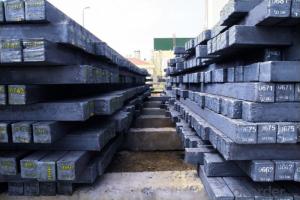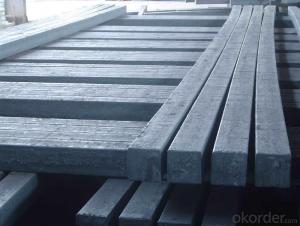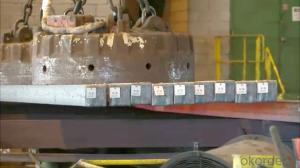Prime Q275 150mm Square Alloy Steel Billet
- Loading Port:
- Shanghai
- Payment Terms:
- TT OR LC
- Min Order Qty:
- 100 m.t.
- Supply Capability:
- 10000 m.t./month
OKorder Service Pledge
OKorder Financial Service
You Might Also Like
Structure of Prime Q275 150mm Square Alloy Steel Billet

Description of Prime Q275 150mm Square Alloy Steel Billet
1. Prepainted steel coil is coated with organic layer, which provides higher anti-corrosion property and a longer lifespan than that of galvanized or galvalume steel sheets.
2. The base metals for prepainted steel coil consist of cold rolled, HDGI Steel, electro-galvanized and hot-dip alu-zinc coated steel. The finish coats of prepainted steel coil can be classified into groups as follows: polyester, silicon modified polyesters, polyvinylidene fluoride, high-durability polyester, etc.
3. The production process has evolved from one-coating-and-one-baking to double-coating-and-double-baking, and even three-coating-and-three-baking.
4. The color of the prepainted steel coil has a very wide selection, like orange, cream-colored, dark sky blue, sea blue, bright red, brick red, ivory white, porcelain blue, etc.
5. The prepainted steel coils can also be classified into groups by their surface textures, namely regular prepainted sheets, embossed sheets and printed sheets.

Main Feature of Prime Q275 150mm Square Alloy Steel Billet
They were one of several reasons for the wind to be taken out of the sails of the recent oil price momentum. Kuwait’s oil minister said that his country would only commit to a production freeze if all major producers are involved, including Iran. We also had Goldman telling us that oil markets will not rebalance at $40/bbl as it throws a lifeline to cash-strapped US producers.
If it is talk of a production freeze that is behind the rally it shows how low expectations have fallen. It is in the nature of oil people to talk the market up. Any bullish crumb is given exaggerated significance and any port in a storm will do. It is all but fact that the oil market will be tighter in the second half of this year when seasonal demand shoots up and US production continues to decline. It was the same picture last year. If OPEC and key non-OPEC production is frozen that will ensure the daily surplus will fall, but in all likelihood there will still be a surplus and there is an enormous global stockbuild to burn off.
Applications of Prime Q275 145mm Square Alloy Steel Billet
A. Corrugated design makes it excellent waterproof performance
B. Materials as prepainted steel sheets, galvanized steel sheets, galvalume (Al-Zn coated sheets) are available to make corrugated sheet.
C.Those material are durable, anti-corrosion in bad weather for 20-30 years based on it's Zinc(Galvanized) coating or AZ (Galvalume) coating.
D. Different shape of the sheet make it suitable for any style of buildings.
E.Easy to install, no need special tools to fix the sheet.
F.Light weight due to high strength to weight ratio of steel. Light weight means easier handling lower shipping costs, easier installation
G. Different color is availbe base on the RAL Standard make your building more beautiful.
H. We will provide the best solutions if you don't have a exact idea of the specification you want for the steel sheet based on your weather conditions, engineering structure, construction budget and so on.

Specifications of Prime Q275 150mm Square Alloy Steel Billet
Product | Billet |
Material Grade | SGCC / SGCH / DX51D+AZ, etc |
Thickness | 0.6-3.0mm |
Width | 500-1500mm |
Tolerance | Thickness: +/-0.02mm , Width:+/-2mm |
Zinc-coating | Z30-150g/m2 |
Technique | Raw material: Hot rolled steel coil --> Cold rolled_>hot dipped galvalume |
Surface | Dried, Chromated, Unoiled |
Spangle | Regular spangle , small spangle, zero spangle |
ID | 508MM 610MM |
Coil weight | 1-25MT |
Export package | Cardboard inner sleeves, Waterproof paper, galvanized steel covered and steel strip packed |
FAQ of Prime Q275 150mm Square Alloy Steel Billet
We have organized several common questions for our clients,may help you sincerely:
1. How Can I Visit There?
Our company is located in Tianjin City, China, near Beijing. You can fly to Tianjin Airport Directly. All our clients, from home or aboard, are warmly welcome to visit us!
2. How Can I Get Some Sample?
We are honored to offer you sample.
- Q:What are the different types of steel billet handling equipment?
- Some different types of steel billet handling equipment include overhead cranes, forklifts, conveyors, and magnetic lifting devices.
- Q:What are the different surface treatments applied to steel billets?
- There are several different surface treatments that can be applied to steel billets, depending on the desired end result and application. Some of the common surface treatments for steel billets include: 1. Shot Blasting: This process involves propelling small metal or mineral particles at high speed onto the surface of the steel billets. Shot blasting helps to remove any surface impurities, such as rust or scale, resulting in a clean and uniform surface. 2. Pickling: Pickling is a chemical treatment that involves immersing the steel billets in an acid solution, typically hydrochloric or sulfuric acid. This process helps to remove any oxide layers or scale from the surface of the billets, resulting in a clean and smooth surface. 3. Phosphating: Phosphating is a chemical conversion coating process that involves immersing the steel billets in a solution containing phosphate salts. This treatment helps to create a thin, adherent, and corrosion-resistant phosphate film on the surface of the billets. 4. Galvanizing: Galvanizing is a popular surface treatment for steel billets that involves coating them with a layer of zinc. This process helps to provide excellent corrosion protection and enhances the overall durability of the steel billets. 5. Painting: Painting is another common surface treatment for steel billets, where a layer of paint is applied to the surface. This can provide both aesthetic appeal and additional protection against corrosion. 6. Electroplating: Electroplating is a process where a thin layer of metal, such as chromium or nickel, is deposited onto the surface of the steel billets using an electrical current. This treatment can enhance the appearance, corrosion resistance, and wear resistance of the steel billets. It is important to note that the choice of surface treatment for steel billets depends on various factors, including the intended use, environmental conditions, and cost considerations. Each treatment offers specific advantages and it is crucial to select the most suitable option to ensure optimal performance and longevity of the steel billets.
- Q:Can steel billets be used in the production of energy-efficient appliances?
- Yes, steel billets can be used in the production of energy-efficient appliances. Steel is a versatile material that is commonly used in the manufacturing of appliances due to its strength and durability. Energy-efficient appliances are designed to consume less energy while performing their intended functions, thereby reducing energy consumption and greenhouse gas emissions. Steel billets can be processed and transformed into various components of energy-efficient appliances such as the outer shells, structural supports, and internal parts. The use of steel in these appliances ensures their longevity and reliability, contributing to their overall energy efficiency. Additionally, steel is a highly recyclable material, meaning that it can be reused or repurposed for other applications at the end of an appliance's life cycle. Recycling steel helps to conserve energy and reduce waste, further supporting the goal of energy efficiency. In summary, steel billets can indeed be utilized in the production of energy-efficient appliances. The strength, durability, and recyclability of steel make it an ideal material choice for manufacturing energy-efficient appliances that contribute to a more sustainable future.
- Q:Can steel billets be used in the production of construction machinery?
- Yes, steel billets can be used in the production of construction machinery. Steel billets are semi-finished products that can be further processed to manufacture various components and parts required in construction machinery. These billets provide a reliable and strong material, making them suitable for the construction industry's heavy-duty applications.
- Q:How do steel billets contribute to the overall strength of a structure?
- The overall strength of a structure is greatly influenced by steel billets, which serve as essential building blocks. These billets, in their semi-finished form, are utilized as raw materials for producing various structural components. The exceptional strength and durability of steel itself are the primary reasons why steel billets enhance the strength of a structure. This makes steel an ideal construction material. When steel billets are incorporated in the manufacturing process, they lay a solid foundation for creating stronger structural elements. Steel billets are typically shaped into different structural components, like beams, columns, and plates, through hot-rolling or forging. This manufacturing process subjects the steel to high temperatures and pressure, leading to a refined grain structure. The refined grain structure significantly improves the strength and toughness of the steel, making it more resistant to deformation and structural failure. Moreover, steel billets can be further processed to achieve specific mechanical properties required for different structural applications. For instance, heat treatment processes like quenching and tempering can enhance their hardness and toughness. Consequently, the steel can endure higher loads and stresses, thereby contributing to the overall strength and stability of the structure. Apart from their inherent strength, steel billets offer advantages in terms of versatility and design flexibility. They can be easily shaped into various sizes and dimensions, enabling engineers to create intricate structural configurations. This versatility allows for the optimization of the structural design, ensuring maximum load-bearing capacity and overall strength of the structure. Furthermore, steel billets possess excellent weldability, allowing them to seamlessly join with other steel components. This ensures the integrity and continuity of the structure, preventing weak points or potential failure zones. By creating a unified and interconnected system, the steel billets contribute to the overall strength and stability of the structure. In conclusion, steel billets significantly contribute to the overall strength of a structure through their inherent strength, refined grain structure, and ability to undergo various heat treatment processes. They provide a strong foundation for manufacturing structural components, enabling them to withstand high loads and stresses. The versatility and design flexibility of steel billets further optimize the structural design, while their excellent weldability ensures the integrity of the structure. As a result, steel billets are essential in constructing resilient and long-lasting structures.
- Q:How are steel billets used in the manufacturing of furniture?
- Furniture manufacturing commonly utilizes steel billets as the primary material for various components. These billets undergo heating and molding processes to take on different shapes, ultimately forming the structural framework of chairs, tables, and bed frames. The use of steel in furniture production is preferred due to its malleability and strength, which contribute to the durability and stability of the final product. Furthermore, steel billets can be easily welded and joined together, allowing for the creation of intricate designs and structures. In summary, steel billets play a crucial role in the manufacturing of high-quality and long-lasting furniture pieces, providing the necessary strength and versatility.
- Q:What are the different surface defects that can be found in steel billets?
- There are several common surface defects that can be found in steel billets. These defects can occur during the manufacturing process or due to handling and transportation. Some of the different surface defects that can be found in steel billets include: 1. Scale: Scale is a type of surface oxidation that appears as a thin layer of iron oxide on the surface of the billet. It can occur during the heating and cooling process and can be removed through mechanical or chemical cleaning methods. 2. Cracks: Cracks can occur due to the improper cooling of the billet or excessive stress during handling. They can either be longitudinal or transverse, and their severity depends on the depth and length of the crack. Cracks can weaken the structural integrity of the billet and should be carefully inspected and repaired. 3. Inclusions: Inclusions are particles or impurities that are trapped within the steel during the manufacturing process. They can be non-metallic or metallic in nature and can affect the mechanical properties of the billet. Inclusions can be categorized as slag inclusions, gas porosity, or non-metallic inclusions like oxides and sulfides. 4. Decarburization: Decarburization is a surface defect that occurs due to the loss of carbon on the surface of the billet during the heating process. It can result in reduced hardness and strength of the steel in the affected area. Decarburization can be minimized by controlling the heating and cooling process and using protective atmospheres. 5. Laminations: Laminations are layers or sheets of non-metallic material that are trapped between the layers of steel during the manufacturing process. They can cause weak spots in the billet and can lead to failure under stress. Laminations can be detected through non-destructive testing methods and should be removed or repaired. 6. Pitting: Pitting is a localized corrosion phenomenon that appears as small pits or cavities on the surface of the billet. It can occur due to exposure to corrosive environments or improper storage conditions. Pitting can reduce the lifespan of the billet and should be treated to prevent further corrosion. It is important to note that these surface defects can vary in severity and impact the quality and performance of the steel billet. Regular inspection, testing, and quality control measures are necessary to identify and address these defects to ensure the integrity of the steel billet and the final products made from it.
- Q:Are steel billets subject to any international standards?
- Steel billets must adhere to international standards, as set by the International Organization for Standardization (ISO). These standards govern the production, quality, and dimensions of steel billets, guaranteeing that they meet specific criteria and are suitable for use in various industries, including construction, manufacturing, and engineering. ISO standards like ISO 683-2 and ISO 16143-1 outline guidelines for the chemical composition, mechanical properties, and tolerances of steel billets. Moreover, international trade organizations such as the International Trade Commission (ITC) and the World Trade Organization (WTO) may also establish regulations and standards for the import and export of steel billets to ensure equitable trade practices and product safety. Consequently, to ensure uniformity, quality, and compliance across different countries and markets, steel billets are subject to international standards.
- Q:What is the difference between steel billets and steel ingots?
- Steel billets and steel ingots are both intermediate forms of steel used in the manufacturing process, but they differ in terms of their shape and size. Steel billets are smaller, square or round-shaped solid bars, typically measuring around 2 to 7 inches in diameter, and are produced through continuous casting or hot rolling processes. On the other hand, steel ingots are larger, rectangular or cylindrical-shaped blocks, with dimensions ranging from a few inches to several feet, and are usually produced through the traditional casting method. The main distinction lies in their size and shape, with billets being smaller and more manageable for further processing, while ingots are larger and require additional steps, such as forging or rolling, to be transformed into usable steel products.
- Q:What are the main safety precautions in handling steel billets?
- The main safety precautions in handling steel billets include wearing appropriate personal protective equipment (PPE) such as gloves, safety glasses, and steel-toed boots to protect against potential injuries. It is important to use proper lifting techniques and equipment to prevent strains and back injuries. Additionally, ensuring a clean and organized work area helps to reduce the risk of slips, trips, and falls. Regular inspection and maintenance of equipment, as well as proper training and supervision, are crucial to maintaining a safe working environment when handling steel billets.
1. Manufacturer Overview |
|
|---|---|
| Location | |
| Year Established | |
| Annual Output Value | |
| Main Markets | |
| Company Certifications | |
2. Manufacturer Certificates |
|
|---|---|
| a) Certification Name | |
| Range | |
| Reference | |
| Validity Period | |
3. Manufacturer Capability |
|
|---|---|
| a)Trade Capacity | |
| Nearest Port | |
| Export Percentage | |
| No.of Employees in Trade Department | |
| Language Spoken: | |
| b)Factory Information | |
| Factory Size: | |
| No. of Production Lines | |
| Contract Manufacturing | |
| Product Price Range | |
Send your message to us
Prime Q275 150mm Square Alloy Steel Billet
- Loading Port:
- Shanghai
- Payment Terms:
- TT OR LC
- Min Order Qty:
- 100 m.t.
- Supply Capability:
- 10000 m.t./month
OKorder Service Pledge
OKorder Financial Service
Similar products
New products
Hot products
Related keywords

































